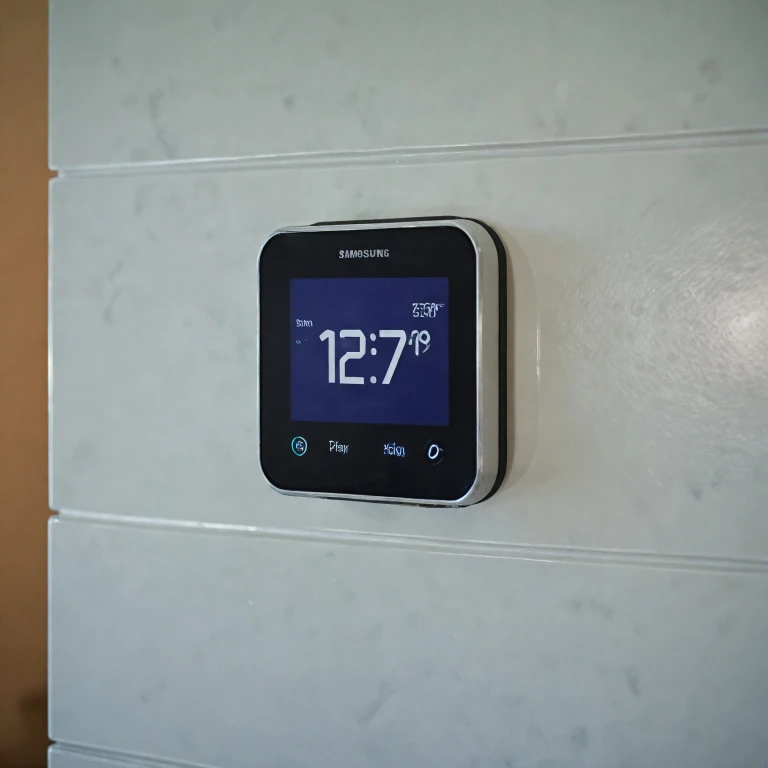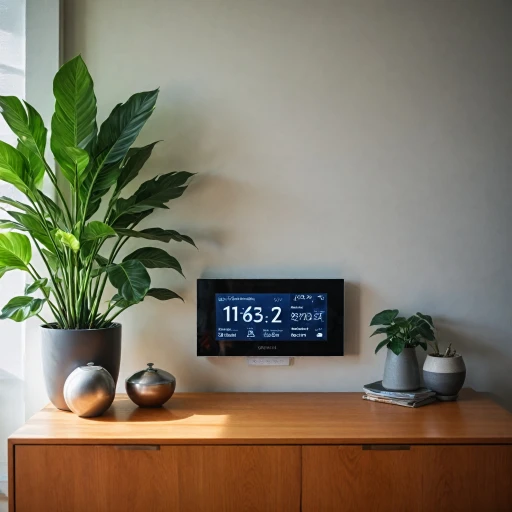The Role of Waterproof Temperature Gauges
How Waterproof Temperature Gauges Function
Waterproof temperature gauges play a crucial role in the effective functioning of smart thermostats. These devices are designed to measure the water temperature in heating and cooling systems, ensuring performance optimization and safety. A waterproof design is essential, as it protects the temperature gauge from moisture, which can affect its accuracy and lifespan. Gauges, especially those used in household thermostats, must endure various environmental conditions. They measure the temperature in systems, which can range from the coolant temperature to the oil temperature. The data collected is displayed on the thermostat's interface, typically in degrees Fahrenheit. This allows users to monitor and adjust settings to maintain a comfortable environment. Incorporating waterproofing into the design of these gauges ensures they can withstand the pressure and size constraints often found in systems like car and truck engines, where mechanical water temperature gauges are commonly used. This also includes wideband gauges and digital water temperature sensors, enhancing the overall performance of smart thermostats. The type of water or coolant used in a system also influences the choice of gauge. For instance, electric water and oil temperature sensors require proper insulation to prevent electric failure caused by water ingress. A reliable gauge kit will often include a sensor, an electric display unit, and a pressure gauge, all designed with waterproofing in mind. With sellers expanding their product lines to include both black and blue Maxtow gauges, the emphasis on waterproof features can't be overstated. Products carrying a gauge SKU should provide clear information on their waterproof capabilities. Among popular choices, Equus is known for delivering quality temperature gauges that withstand typical water temp challenges, enhancing trust and reliability. Thus, understanding the development of waterproof temperature gauges in smart thermostats not only helps in evaluating their current offerings but sets the precedent for future trends and innovations in this field.Benefits of Waterproofing in Temperature Gauges
The Advantages of Waterproof Technology in Thermostats
The incorporation of waterproofing in temperature gauges brings about remarkable benefits that enhance both the performance and durability of smart thermostats. As technology continues to advance, the significance of reliable components cannot be overstated. Waterproofing is one such innovation that has transformed how these devices function in various environments. One of the most notable advantages is the protection against moisture and dust. This is crucial in ensuring that the gauges remain operational under various conditions, including exposure to water, without compromising the performance of the thermostat. By preventing water and dust intrusion, waterproof temperature sensors maintain accurate readings, which is critical when controlling heating and cooling systems. Additionally, products designed with waterproof features tend to have a longer lifespan. This offers an excellent return on investment for consumers. The durability ensured by water-resistant designs means fewer replacements and lower maintenance costs over time. This increases the product's reliability, making it an excellent choice for those seeking high performance without frequent repairs. Moreover, in regions with high humidity or areas prone to water exposure such as kitchens or bathrooms, waterproof temperature gauges are particularly valuable. These gauges can withstand varied degrees of moisture pressure without faltering, maintaining precision in temperature delivery and display. As the market continues to develop, sellers are frequently including advanced waterproof technologies in their offerings. This raises the standard of quality for all temperature gauges, regardless of type—be it an electronic water temperature gauge or an oil temperature gauge. Consumers are increasingly opting for models like the black Equus or the blue Maxtow, which boast water-resistant features, to ensure seamless operation. With these improvements, smart thermostats equipped with waterproof temperature sensors are setting a new benchmark in environmental sustainability and consumer satisfaction. For further insights on the broader advantages of smart thermostats, consider exploring the benefits of a Bryant thermostat.Challenges in Integrating Waterproof Technology
Overcoming Integration Complexities of Waterproof Technology
Integrating waterproof technology into smart thermostats comes with its own set of challenges, primarily due to the need to maintain the precision of temperature gauges while ensuring durability against moisture exposure. The nature of water and its interaction with electronic components can often complicate the performance of devices like temperature sensors. One of the primary hurdles lies in balancing size and functionality. Waterproof temp gauges need to be compact enough to fit into sleek thermostat designs yet robust enough to measure accurate temperature readings in degrees Fahrenheit. These readings can be influenced by environmental pressures such as humidity and coolant exposure, making the task even more complex. Manufacturers often face difficulties in choosing the right materials and types of sensors that can withstand water pressure and temperature fluctuations. Mechanical water temperature gauges, often found in car truck models, need adaptations to function seamlessly in a domestic setting, further complicating design efforts. Moreover, the delivery and display of data from these gauges must be efficient and clear, not just on traditional dashboards but also on digital displays that aid easy reading across various lighting conditions. Whether it's an oil temperature sensor or a digital water temp gauge, ensuring precision in data output while implementing waterproofing is non-trivial. To tackle these challenges, some brands have turned to innovative solutions, creating electric water sensors and developing a wideband gauge system that enhances the accuracy of temperature readings without compromising waterproofing. Exploring successful product designs that incorporate such features, you can compare various options, understanding the merits of each technology. This helps potential buyers in choosing between waterproof and non-waterproof thermostat products based on their individual needs and the specific demands of their environment. For a deeper dive into the innovative solutions addressing these challenges, check out this guide to smart thermostat design.Innovative Solutions in Smart Thermostat Design
Exploring Cutting-edge Designs in Smart Thermostats
The rapidly evolving world of smart thermostats has brought about a host of innovative solutions. These designs integrate waterproof technology in temperature gauges to enhance both functionality and durability. One of the standout features is the use of advanced sensors that monitor a wide range of temperatures, from coolant temperature to oil temperature. This versatility ensures that your smart thermostat performs optimally, even in challenging conditions. The type water and pressure gauges integrated within these devices are designed to withstand various elements, from electric water pressure to high degrees Fahrenheit. As a result, users enjoy reliable and accurate readings without the risk of damage from water exposure. Another key innovation is the incorporation of a digital display that allows easy monitoring of temperature gauges. Products like the black equus and blue maxtow come with precise gauge displays that offer clear readings of degrees Fahrenheit. This feature is particularly beneficial for car truck owners who need accurate temp readings at a glance, from mechanical water to wideband gauge data. Moreover, manufacturers have developed compact designs that accommodate smaller gauge kits without compromising on quality. This trend towards minimizing product size while maximizing performance means that even if you have limited space, you can still enjoy the benefits of a smart thermostat with waterproof technology. In addition, sellers are now offering comprehensive gauge water and electric water gauge kits to ensure seamless integration into existing systems. This includes sensor delivery options that provide efficient pressure gauge readings regardless of temp changes or water temp fluctuations. As this technology continues to advance, it is evident that smart thermostats are not just becoming smarter, but also more durable and reliable.Comparing Waterproof and Non-Waterproof Options
Evaluating Waterproof Versus Non-Waterproof Temperature Gauges
When it comes to smart thermostats, the choice between waterproof and non-waterproof temperature gauges can significantly affect the device's performance and longevity. Understanding these differences is crucial for making an informed decision.
Waterproof temperature gauges offer distinct advantages, particularly in environments where exposure to moisture is inevitable. These gauges are designed to withstand water and humidity, ensuring consistent performance even under challenging conditions. For instance, in areas prone to high humidity or accidental water exposure, a waterproof gauge can prevent malfunctions and extend the lifespan of the thermostat.
On the other hand, non-waterproof temperature gauges might be suitable for more controlled environments where the risk of water exposure is minimal. These gauges often come at a lower cost, making them an attractive option for budget-conscious consumers. However, they may not offer the same level of reliability in terms of water resistance, which could impact their performance over time.
When comparing these options, consider the following factors:
- Environment: Assess whether the thermostat will be used in a location with high humidity or potential water exposure.
- Performance: Waterproof gauges typically maintain accurate temperature readings even in adverse conditions, such as varying degrees Fahrenheit.
- Cost: Non-waterproof options may be more affordable but could incur additional costs if water damage occurs.
- Durability: Waterproof gauges are generally more robust, providing a longer service life.
Additionally, consider the specific needs of your heating and cooling system. For example, in vehicles like car trucks, a mechanical water temperature gauge might be more appropriate, while a digital water gauge could be ideal for home use.
Ultimately, the decision between waterproof and non-waterproof temperature gauges should align with your specific requirements and environment. By weighing these factors, you can select a product that not only meets your needs but also offers reliable performance and durability.








